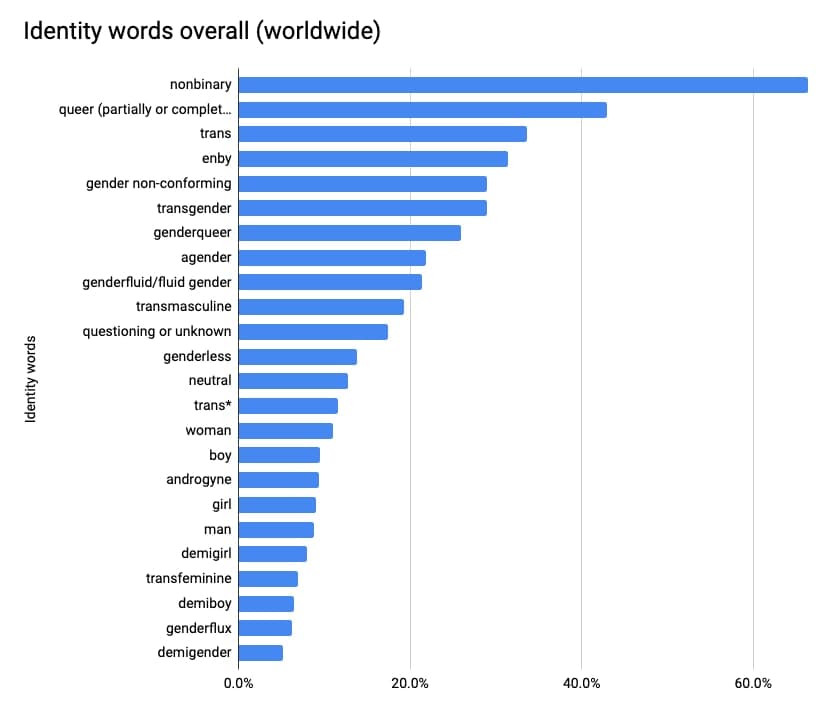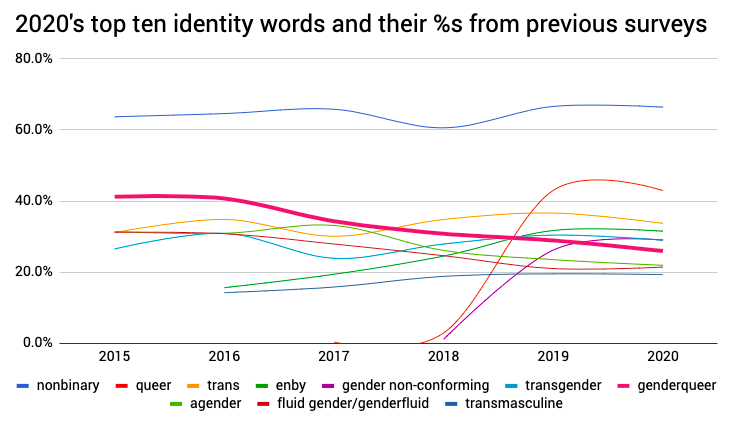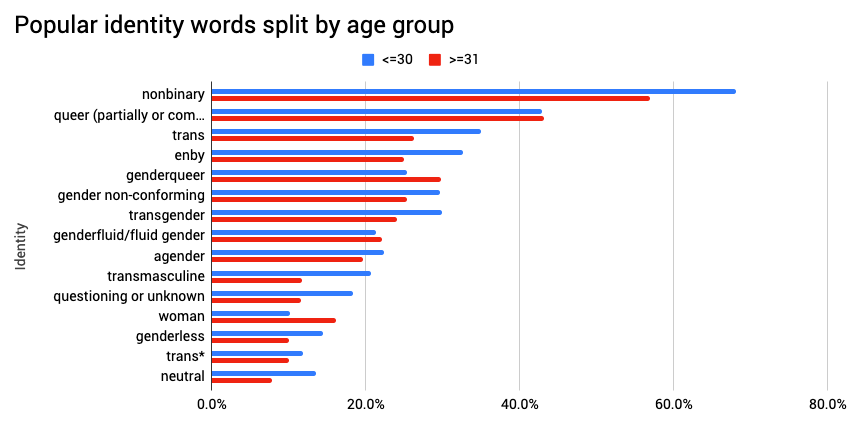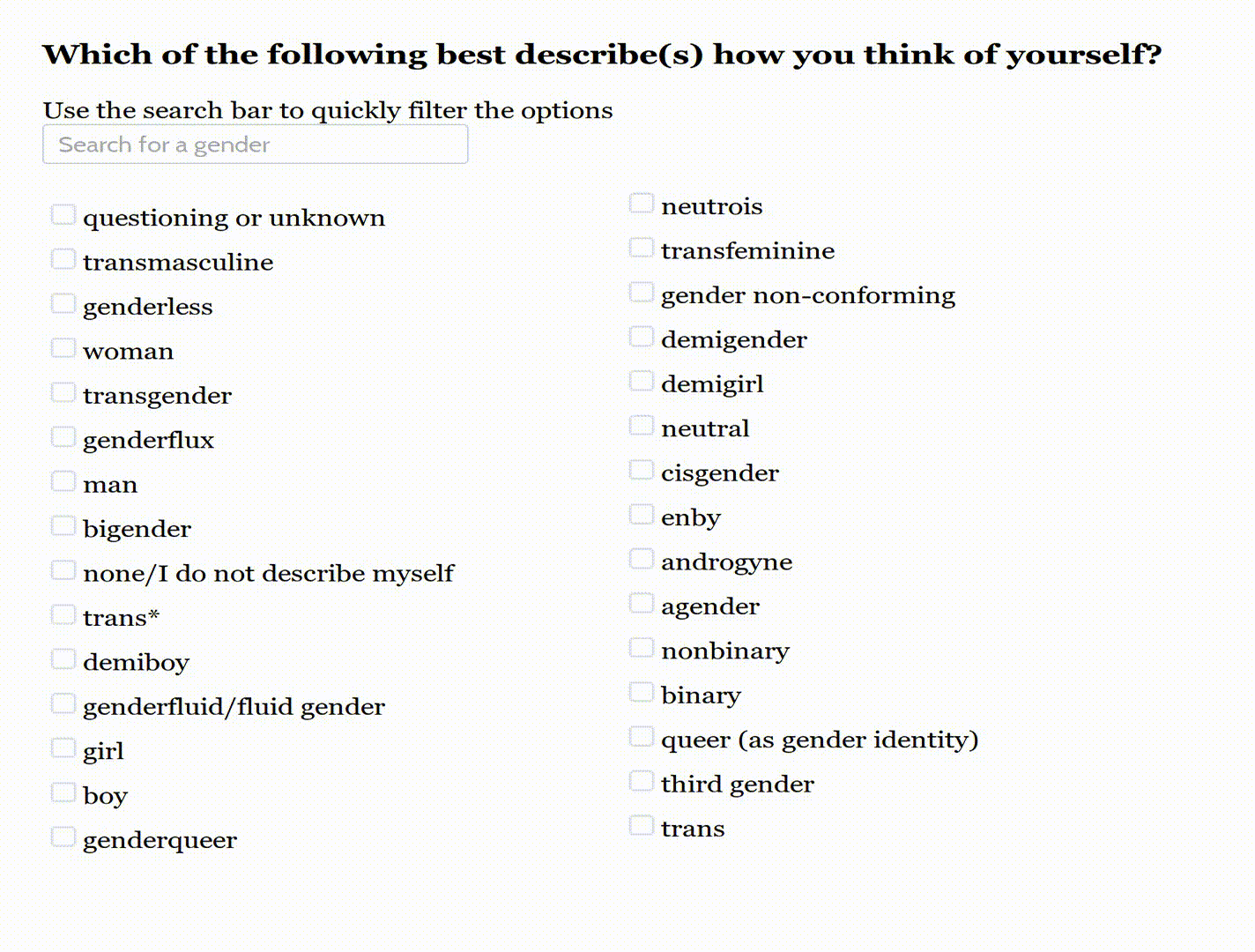This year’s Gender Census, aimed at everyone whose gender(s) or lack thereof are not adequately described by the gender binary of “always, solely and completely male OR always, solely and completely female”, was open from 12th February until 7th April 2020. There were 24,576 usable responses. You can see the spreadsheet of responses via the full report.
This report will summarise the responses for the first question, regarding identity.
As in previous years, I asked:
Which of the following best describe(s) in English how you think of yourself?
There were 30 checkbox options presented in a random order, largely based on which answers were chosen by over 1% of participants last year. (More on how I’m updating the selection process later.)
Here’s a graph of the results:

And here’s the top 5:
- nonbinary – 66.4% (down 0.2%)
- queer (partially or completely in relation to gender) – 42.9% (down 0.1%)
- trans – 33.7% (down 2.9%)
- enby – 31.5% (down 0.2%)
- gender non-conforming – 29.0% (up 2.8%)
Last year queer was added to the checkbox list because it was entered into the textbox by over 1% of participants (2.9%) the previous year, and it rocketed to second place. At the time I was very surprised by this, and I had some reservations about the data quality, because the word “gender” isn’t mentioned in the question. Perhaps people were choosing queer as a checkbox option because the question isn’t clear enough and they identify as queer in terms of their sexual orientation? This year, the queer checkbox option was a little longer:
queer (partially or completely in relation to gender)
… and it was still entered by around the same proportion of participants. I now feel satisfied that these results are representative of participants’ gender identities or similar, and not entered in error. I will retain this wording for future surveys, just in case.
Aside from that, nothing particularly stands out as a new trend. Here’s the graph of the top 10 identity words from the past seven surveys:

Genderqueer continues its gradual downward trend, and I’ve bolded that line so you can see it more clearly. Last year it was sixth most popular, and this year it’s seventh. Gender non-conforming has climbed a little and now sits above transgender, but only by a very slim margin of 0.05% (12 people) – just enough to push transgender out of the top 5.
The 1% and 3% boundaries
In order to talk about the textbox entries and the words I will be adding and removing from the checkbox list, I’ll first have to explain a decision I made last year.
In 2019 the checkbox identity list had 30 terms on it, which was long enough that people couldn’t find their identities. Several people asked that the words be sorted in alphabetical order to make them easier to find, but if I do that I will risk primacy and recency bias – the phenomenon of participants being more likely to choose options at the start and end of a list respectively, the solution for which is to randomise the list for each participant.
The 1% boundary ensures that a word only gets added to the checkbox list when enough people write it into the textbox, but I can’t use the same boundary for removing terms from the checkbox list, because most words get chosen around four times more often when they’re presented as easy checkboxes that remind participants of their existence.
So, last year I decided to create a removal boundary of 3%. The proposal: if a checkbox identity term is chosen by under 3% of participants, it will be removed from the checkbox list for next year. When I ran the numbers in 2019, I found that the few terms that fit that criterion were words I have mainly seen used by older people, and older people are underrepresented in online surveys. If I remove checkbox terms that are mostly used by order people, I am further excluding them from a survey that is already less accessible to them.
The only solution I could think of was to start asking for participants’ ages every year, and then remove words that are chosen by under 3% of both under-30s and over-30s. This year I asked for age, and let people choose in 5-year increments, to reduce identifiability. I then split the popularity of identity words by age: participants 30 and younger, and participants 31 and older.
The checkboxes
Here’s how the top 5s look when split by age group:
30 and younger
- nonbinary – 68.0%
- queer (partially or completely in relation to gender) – 42.9%
- trans – 35.0%
- enby – 32.6%
- transgender – 29.8%
31 and older
- nonbinary – 56.9%
- queer (partially or completely in relation to gender) – 43.1%
- genderqueer – 29.8%
- trans – 26.2%
- gender non-conforming – 25.3%
Broadly similar at the top, though older participants were more likely to choose genderqueer and gender non-conforming, whereas younger participants were more likely to choose enby and transgender. (You can see more on the word “enby” and its age connotations in the first report here.)
Here’s the new top 15, calculated as an average percentage from both age groups:

This graph shows that in this new overall top 15, people aged 31 and over were significantly more likely to identify as genderqueer or woman. But I think it is interesting to note that the two groups are much more similar than they are different.
Words to remove (under 3%)
On the checkbox list, only three terms were chosen by under 3% of participants in both age groups: third gender, cisgender, and binary.
I will be keeping cisgender and binary on the list for next year, because I have a policy of offering words that are opposites of words that need to stay on the list. In this case, they act as controls for transgender and nonbinary.
However, third gender has been on the list since the first survey because someone suggested it when I casually crowdsourced checkbox ideas, and it has always been pretty low on the popularity list. Last year it was 2.2%, and this year it was about the same: 2.2% for under-30s, and 2.3% for over-30s. I looked into the phrase a little more, and found that it’s essentially a term used by white anthropologists to describe non-straight-non-cis people in non-Western societies. That could include LGB people and binary trans people, in addition to people whose genders are not described by the M/F binary. On the basis of racism alone I’ll be very happy to remove this term from the checkbox list for next year.
If there are no words to remove next year, I will consider increasing the removal threshold to 4%.
Textbox identity words
This part is always a joy for me, and the age group thing made it more interesting this year. There were 3,546 unique identities written into the textboxes, which is one new term for every seven people.
Taking all write-ins at face value, there were two words that were typed in by over 1% of participants in either age group: human, and female.
This is probably the point at which some of you will start to feel nervous. “Adult human female” is the slogan of some gender-critical/trans-exclusionary radical feminists. Most years the survey link gets shared in gender-critical circles and we get a handful of responses from people identifying as women, some of them trying to disrupt the survey and some earnestly sharing their experiences of their own genders.
This year I thought more about the issue and came to a decision about whether or not these responses should be included, and you can read more about that here, but the summary is: many gender-critical women responding to the survey describe lifelong experiences of gender dysphoria and a relationship with their bodies that could have been recounted by any nonbinary participant. I invite anyone to participate who feels that the gender binary has failed them, and gender-critical women/TERFs should be included in that group.
So, if a gender-critical woman’s response isn’t abusive or hurtful, it can stay. That means that we had plenty of people who entered the words adult, human and female into the textboxes, and I have to decide what to do about that.
- Adult didn’t make the cut. For some reason it wasn’t entered as often as human and female.
- Human was an easy decision. It can be assumed that if one is filling in a survey on the internet using a keyboard, one is probably human. That doesn’t need to be included on the list.
Female is harder. I have previously debated whether or not to include male and female on the checkbox list, and every time I have decided that the risk is too great. My experience is that many trans and nonbinary people are uncomfortable enough being asked about the gender they were assigned at birth and their biological sex that they would be much more likely to duck out of any survey even vaguely alluding to it. Since male and female were never entered by over 1% of participants I never had to consider it at all – until now.
So, when it became apparent while the survey was open that female might break 1%, I ran some informal polls on Twitter and Mastodon, and combined the results in a spreadsheet. I wanted to find out whether people associate male/female with biological sex and/or gender assigned at birth, and how people would feel about them being included as visible checkbox options. Here’s a summary:
- 81% of voters said that male and female relate to bodies/sex/anatomy exclusively or in at least some contexts. In the extremes, people were a little more likely to say that male/female relate to bodies/sex only, as opposed to gender only. This fits my experience of the trans narrative that sex and gender are different things that are incongruent in trans people.
- People were on the whole in favour of male and female being words on the checkbox list distinct from man and woman, but it was very close.
- When asked how they would personally feel seeing male/female on the checkbox list, it became a little less ambiguous – only 18% said they’d feel uncomfortable or otherwise negative. I say “only” – one in five is a lot of participants. I suspect that would still lead to a lot of drop-outs.
- To act as something like a control, I asked about an issue that is often controversial: the inclusion of it/it pronouns in the pronoun checkbox list. 82% said they felt good about them being included, compared to only 54% of people who would feel good about male and female being included.
For now I conclude that the words male and female correlate with physical and anatomical sex often enough that it would interfere with the quality of the data. Until the balance tips from “male/female = body” to “male/female = gender”, I don’t think I will feel confident that I can add them to the list without affecting survey results and participants’ inclusion.
So that’s it for the words counted at face value – nothing will be added next year.
However, taking into account variations of spelling and similar, the picture looks a little different.
Some textboxes contained phrases like “lesbian (yes, as a gender identity)”, which I found interesting! So I started to count as many of these oddballs as I could, ensuring along the way that they fit the spirit of the question. The following words were entered in some way by at least 1% of participants in one of the two age groups:
- lesbian
- butch
- femme
Butch and femme are familiar to me as words that describe an experience of gender outside of heteronormativity, but lesbian in this context was new to me, which is always exciting!
Interestingly, I didn’t see anything like the same trend for terms that usually describe gay men, such as gay, bear, etc. For fairness, I will include gay if I include lesbian, in the same way that I include cisgender if I list transgender. And, like queer, I will feel more confident in the data if I can know for sure that participants are choosing words in the spirit of the question – gender identity rather than sexual orientation.
That means next year I will be adding four (!) new terms to the checkbox list:
- lesbian (partially or completely in relation to gender)
- gay (partially or completely in relation to gender)
- butch
- femme
The removal of one term and the addition of four will make the identity list 33 words long. This is very unwieldy! People were already struggling to find familiar identity words at 30. Next year when I crowdfund I will be raising money to pay for SmartSurvey to make a custom question layout for us, that looks something like this mock-up a nice person made last year:

A search box, and when you start typing the term you’re looking for, the list of checkbox options filters out everything that doesn’t fit. So if you typed “dem” you’d be left with demiboy, demigirl, and demigender.
The quote that SmartSurvey gave me is £400 plus VAT – so I assume £480. Oof! But I think it would be a one-off fee, and I think it would be worth it.
Closing thoughts
- You all are super interesting!
- “Nonbinary” is the most popular, but it’s still only good for two-thirds of us.
- The identity list is getting very long.
- Genderqueer is down, queer is up.
- The line between gender and sexuality is delightfully blurry when you get right down to it.
- Age is just a number.
It’s already August and I’ve only done two reports of maybe four or five. In addition to this whole pandemic situation I’ve also been going through a lot in relation to disability issues, housing, etc. I’m doing my best, and I won’t give up!
Thanks for reading! If you enjoyed it and would like to give something back, you could increase your chances of taking part in future surveys by following on Tumblr, Twitter or the Fediverse, or subscribing to the mailing list. Alternatively, you could take a look at my Amazon wishlist.
2020-08-07
email: hello@gendercensus.com